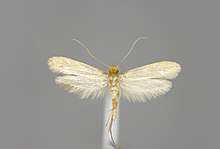Bookworm (insect)
Bookworm is a general name for any insect that is said to bore through books.[1][2]


The damage to books that is commonly attributed to "bookworms" is, in truth, not caused by any species of worm. Often, the larvae of various types of insects including beetles, moths and cockroaches, which may bore or chew through books seeking food, are responsible. Some such larvae exhibit a superficial resemblance to worms and are the likely inspiration for the term, though they are not true worms. In other cases, termites, carpenter ants, and woodboring beetles will first infest wooden bookshelves and later feed on books placed upon the shelves, attracted by the wood-pulp paper used in most commercial book production.
True book-borers are uncommon. The primary food sources for many "bookworms" are the leather or cloth bindings of a book, the glue used in the binding process, or molds and fungi that grow on or inside books. When the pages themselves are attacked, a gradual encroachment across the surface of one page or a small number of pages is typical, rather than the boring of holes through the entire book (see images on right).[3]
The term has come to have a second, idiomatic use, indicative of a person who reads a great deal or to perceived excess: someone who devours books metaphorically.
Booklice
The booklouse, also known as a paperlouse, is a soft-bodied, wingless insect in the order Psocoptera (usually Trogium pulsatorium), typically 1 mm or less in length. Booklice feed on microscopic molds and other organic matter found in or on aging items that have been stored in places that lack the climate control necessary to inhibit organic growth. Areas of archives, libraries, and museums that are cool, damp, dark, and generally undisturbed are common sites for such growth, generating a food source which subsequently attracts booklice. Booklice will also attack bindings, glue, and paper.
Despite their name, booklice are not considered to be true lice, as they do not feed on a living host.
By the 20th century, bookbinding materials had developed a high resistance against damage by various types of book-boring insects.[4] Many museums and archives in possession of materials vulnerable to booklouse damage employ pest control methods to manage existing infestations and make use of climate control to prevent the growth of potential booklouse food sources.[5]
Other book-eating insects
Beetles
Of the quarter million species of beetles, some adults damage books by eating paper and binding materials themselves. However, their larvae do the most damage. Typically eggs are laid on the book's edges and spine. Upon hatching, they bore into, and sometimes even through, the book.[3]

Woodboring beetles
- Common furniture beetle[6]
- Deathwatch beetle[7]
- The genus Gastrallus
- Indian bookworm beetle
- Australian spider beetle
- Cigarette beetle[8]
- Drugstore beetle[8]
Skin beetles
These beetles have been known to feed on leather bindings.
- Furniture carpet beetle
- Museum beetle
- Common carpet beetle
- Varied carpet beetle
- Fur beetle
- Black carpet beetle[9]
- Dermestes coarctatus
- Larder beetle[10]
- Dermestes maculatus
- Dermestes vorax
- Khapra beetle
- Reesa
- Trogoderma versicolor
- Odd beetle
Powderpost beetles
- African powderpost beetle
- Brown powderpost beetle
- Black powderpost beetle
Termites
Termites are the most devastating type of book eating pest. They will eat almost every part of a book including paper, cloth, and cardboard, not to mention the damage that can be done to shelves. Termites can make entire collections unusable before the infestation is even noticed.[3]
.jpg)
Ants
Some species of ants can damage books in a way that is similar to termites.[11]
- Black carpenter ant
- Camponotus obscuripes
- Hercules ant
Moths
Moths that feed on cloth will also feed on bookbindings, decaying organic material (which includes paper), and mold.
Fungus moths
- Carpet moth
- Case-bearing clothes moth
- Clothing moth
 Tineola bisselliella, common clothing moth
Tineola bisselliella, common clothing moth
Cockroaches
Bookdamaging cockroach species chew away at the starch in cloth bindings and paper. Their droppings can also harm books.[3]
Thysanura[12]
These insects consume portions of book that contain polysaccharides. Paper that is slightly ragged at the edges is usually the work of silverfish.[3]

Pseudoscorpions
Pseudoscorpions love old dusty books where they can find their prey: The booklouse.[15]
Management
Pesticides can be used to protect books from these insects, but they are often made with harsh chemicals that make them an unattractive option. Museums and universities that want to keep their archives bookworm free without using pesticides often turn towards temperature control. Books can be stored at low temperatures that keep eggs from hatching, or placed in a deep-freezer to kill larvae and adults. The idea was taken from commercial food storage practices, as they are often dealing with the same pests. [14][16]
Idiom

The term is also used idiomatically to describe an avid or voracious reader,[17][18] an indiscriminate or uncritical reader, or a bibliophile. In its earliest iterations, it had a negative connotation, e.g., an idler who would rather read than participate in the world around him or a person who pays too much attention to formal rules and book learning.[19] Over the years its meaning has drifted in a more positive direction.[20]
See also
References
Citations
- "Bookworm insect". Encyclopædia Britannica, inc. Retrieved April 6, 2018.
- Wiener, Ann Elizabeth (2018). "What's That Smell You're Reading?". Distillations. 4 (1): 36–39. Retrieved July 11, 2018.
- "Pest Control | Library Preservation and Conservation Tutorial". Cornell University Library. Retrieved 20 June 2019.
- Murray, Stuart (2009). The Library: An Illustrated History. New York, NY: Skyhorse Publishing. p. 198.
- "Bugs That Eat Books!". Colonial Pest Control Inc. 2013-03-21. Retrieved April 6, 2018.
- "Woodworm Anobium Punctatum". buildingconservation.com. Retrieved April 6, 2018.
- "Deathwatch beetle". Encyclopædia Britannica, inc. Retrieved April 6, 2018.
- "Drugstore beetle". University of Florida. Retrieved April 6, 2018.
- "Black Carpet Beetle". Penn State. Retrieved April 6, 2018.
- "Larder beetle". Canadian Grain Commission. 2013-08-30. Retrieved April 6, 2018.
- Harbison, Brad (4 August 2015). "A Termite-Damaged Book…Or Is It?". Pest Control Technology. Retrieved 20 June 2019.
- "Identifying and controlling clothes moths, carpet beetles and silverfish". Department of Primary Industries and Regional Development. Retrieved April 6, 2018.
- "Brown house moth Hofmannophila pseudospretella (Stainton)". Canadian Grain Commission. 2013-08-30. Retrieved April 6, 2018.
- Strang, Thomas J. K. "A Review of Published Temperatures for the Control of Pest Insects in Museums" (PDF). p. 3.
- Crew, Bec (August 25, 2014). "How Book Scorpions Tend to Your Dusty Tomes". Scientific American. Retrieved 20 June 2019.
- The Yale Non-toxic Method of Eradicating Book-eating Insects by Deep-freezing Kenneth Nesheim
- "Bookworm". Oxford English Dictionary. Lexico. Retrieved June 19, 2019.
- Emigh, Karen; Dana, Steve (May 15, 2007). Bookworm: Discovering Idioms, Sayings and Expressions. Arlington, Texas: Future Horizons. p. 3. ISBN 9781932565423.
- "Bookworm". synonyms. Retrieved June 19, 2019.
- "Is 'bookworm' positive or negative?". Merriam Webster. Retrieved June 18, 2019.
Further reading
| Wikimedia Commons has media related to Bookworms. |
| Look up Bookworm in Wiktionary, the free dictionary. |
- "John Francis Xavier O'Conor, Facts about bookworms: their history in literature and work in libraries (New York: Francis P. Harper, 1898.)
- Dr. John V. Richardson Jr., PhD."Bookworms: The Most Common Insect Pests of Paper in Archives, Libraries, and Museums".
- "Timber Borers – Anobium & Lyctus Borers"
- "Study on integrated pest management for libraries and archives" – prepared by Thomas A Parker for the General Information Programme and UNISIST (Paris: Unesco, 1988)

